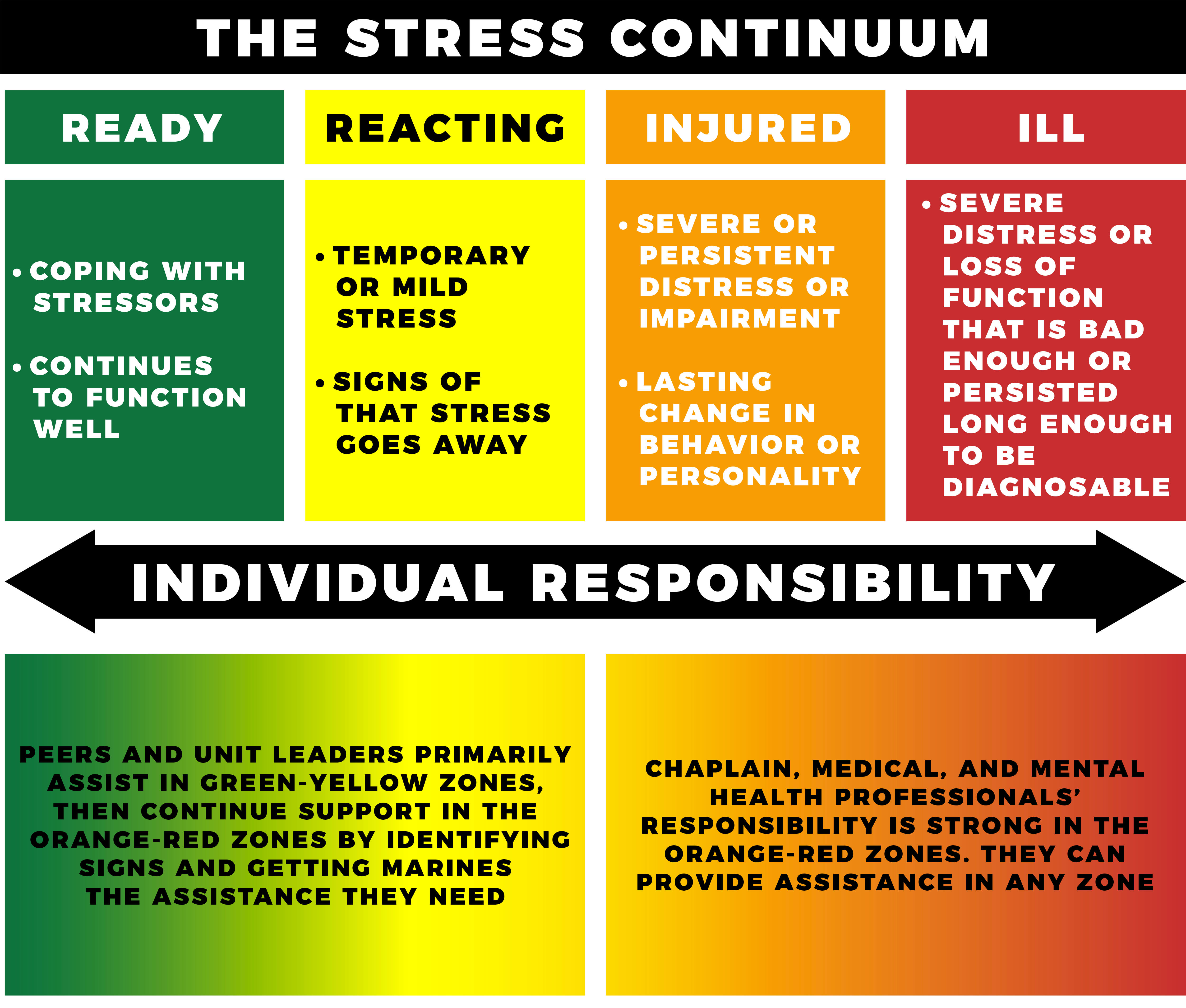Know Your Zone – The Stress Continuum

No Marine or Marine spouse is immune to stress.
The Stress Continuum is a foundational tool of the Combat and Operational Stress Control, or COSC program, that gives us common, easy-to-understand language to communicate about stress, whether a Marine or a spouse. This tool helps better monitor our stress and the stress of others.

The Stress Continuum recognizes and normalizes the entire spectrum of stress responses and outcomes.
- The Green Zone is not the absence of stress, but rather represents coping well with stressors. Our lives will rarely be without stress, and we need some stress in our lives to accomplish tasks. It’s important to strengthen against stress daily. Some simple but effective strategies may include making sure we get healthy sleep, exercise, and nutrition to be better prepared when stressors arise.
- The Yellow Zone represents mild and reversible stress. We all experience Yellow Zone stress. Most of us experience some Yellow Zone stress on a regular basis and most of us fluctuate between the Green and Yellow Zone frequently. A wide range of situations may put us in the Yellow Zone including a PCS move, the workup for a deployment, or changes for our children at school. When we notice our stress level elevate, we can work to ensure adequate sleep and rest, actively work to manage what we can, and check in with a chaplain or other resource if the stress is getting worse rather than improving.
- The Orange Zone represents severe and persistent stress. If we think that we, or someone we know, are in the Orange Zone, we may want to consider professional help. Some of the stressors that may cause Orange Zone stress are grief and loss, wear and tear, life threat, and inner conflict. It may be especially important to pay attention to stress zone changes before, during, and after deployments, or following critical incidents.
- The Red Zone is on the far right of the continuum. Most people will not experience Red Zone stress, and even for those that do, with proper professional treatment, they can work toward resiliency and wellness. Only a mental health professional can determine if someone is in the Red Zone, but if you suspect this, it is important to get professional help for the person.
There are a few more points to highlight about this tool:
Look at the gray bar along the center of the continuum that says “Individual Responsibility.” For Marines, monitoring and managing the Stress Continuum is a shared responsibility of unit leaders, but individuals also bear responsibility for continuously monitoring and managing stress for themselves and for their fellow Marines.
For Marine families, monitoring stress is also a shared responsibility. When a spouse is experiencing elevated stress, it may be the spouse or partner who first notices this. When this happens, we can check in with our partner to see what, if any, support is needed. Sometimes just having a person to talk to who is capable of empathy for the same scenario can make a huge difference in how someone copes with stress. Connectedness is important for spouses.
The goal is to keep Marine families in the Green “Ready” Zone as much as possible and to return them to that zone as quickly as possible after leaving it.
Marine commanders can select Marines from their unit to learn more about COSC and serve on the Operational Stress Control and Readiness (OSCAR) Team. OSCAR Team Members act as sensors and help address stress early in the unit.
Marine spouses can learn more about COSC and see the Stress Continuum Decision Flowchart for Spouses in Appendix H of Marine Corps Training Publication (MCTP) 3-30E. MCTP 3-30E Formerly MCRP 6-11C.pdf (marines.mil)
COSC SharePoint: Combat and Operational Stress Control Capability - Home (sharepoint-mil.us)